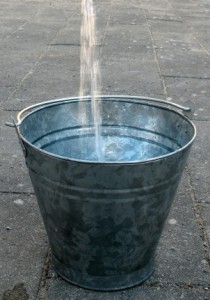[A version of this article ran in Lehigh Valley Business Journal week of September 2, 2013.]
Cash flow is a popular topic of conversation with small business owners. They are always looking for ways to make their cash go farther.
Unfortunately, they make the same mistake as new parents who spend nine months preparing for the baby’s delivery, but very little time preparing to raise the child for the next 21 years. Business owners similarly focus on their product, service, and taxes, but not much on how to handle and manage cash.
Banks understand this, so they offer ‘cash flow management’ and Sweep Accounts. They make it so convenient for you to manage your cash that they will sweep it when you have money, and sweep it when you don’t. So what is all this sweeping about?
If you have a savings, checking, and line of credit with a bank, they calculate the total balance of your accounts. If you have more than you need in your checking account, they’ll put the excess cash in a savings account or pay down your line of credit. If you don’t have enough in your checking account, they’ll automatically borrow from your line of credit.
“Great!” you say. “One less thing to worry about.” Unfortunately, out of sight means out of mind. You’re not tending to your cash flow.
So do I suggest we go back to having three envelopes: one for deposit, one for expenses, and one for loan pay-back? No, but I do want to emphasize the lack of awareness that always comes with these automatic transfers.
When easy money is there to pay bills and draw down your line of credit, you can fall into what I call ‘cash flow apathy.’ Just $100 here and $1,000 there–and before you know it, you’re $15,000 or $30,000 in debt. You think, “We’ll pay it down next month,” but next month comes and goes with no improvement.
The solution is to understand two crucial things–awareness of what is happening with your cash, and the purpose of your line of credit. And there are rules that you need to follow. Rule #1: operating expenses should be paid out of operating income. Rule #2: your line of credit should only be used for working capital needs.
Technically, working capital is current assets less current liabilities. My user-friendly definition: it’s the money you need for a temporary boost in cash to pay for additional inventory or a temporary delay in receiving accounts receivable funds. Lines of credit should only be used for working capital needs.
So now we come to the cash flow bucket.
Business owners with the ‘convenience’ of a sweep account see it as one big bucket. The cash from sales, accounts receivable and money from their line of credit all go into this bucket account. Payments for operating expense, payroll, and any other checks you may write come out of the same bucket. That is how you lose awareness of what money is paying for which expenses.
This lack of awareness leads to unwise use of cash. For instance, I once watched an individual give himself a $20,000 bonus when the profit or loss didn’t indicate he deserved it. But, since the money was there, the line of credit paid his bonus.He had lost awareness of whether or not his operating income was paying operating expenses.
You must plug the hole that allows all expenses to be paid, and the line of credit that keeps filling the bucket. Once you know that the hole exists, you need to know how to fix it. But that is a discussion for another article.





Leave a Reply